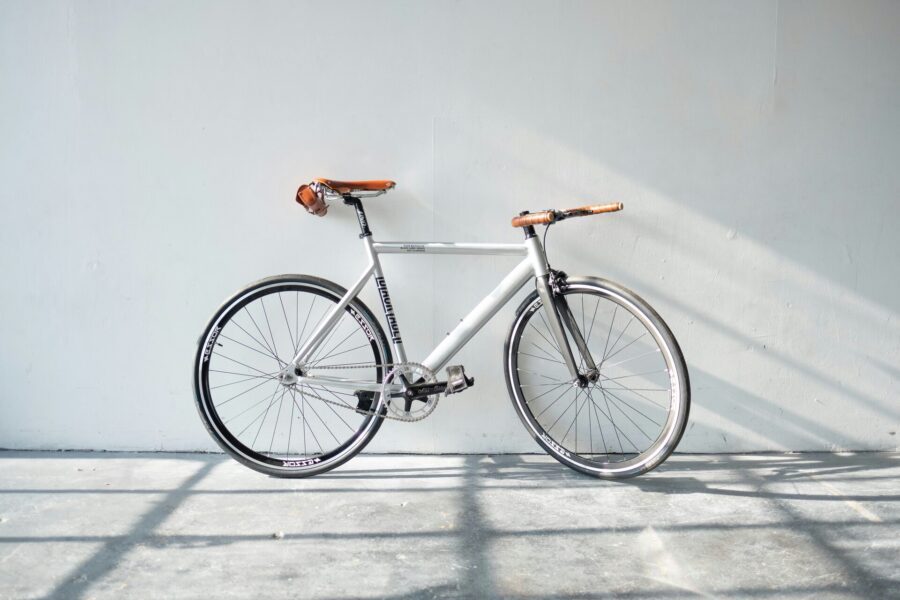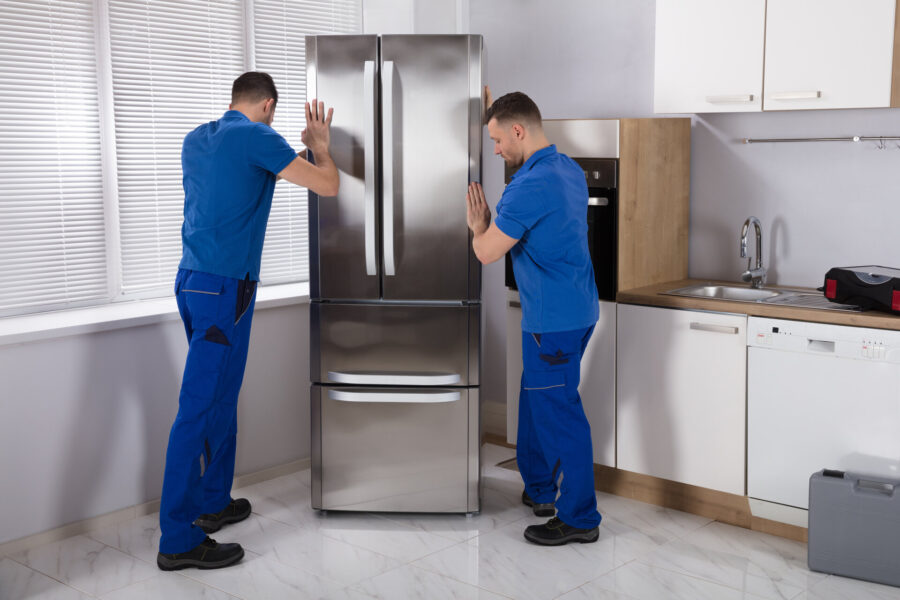Moving to a new home is an exciting journey, but it comes with its fair share of challenges, especially when it comes to boxing up. One often-overlooked aspect of the relocation process is how to pack clothes for moving and protect them during the move. Having a well-organized approach to packing your wardrobe can save you time, prevent wrinkles, and make the unpacking process at your new home a breeze.

How to Pack Clothes for Moving?
To wrap clothes, start by sorting and decluttering your wardrobe. Choose the right packing method (folding, rolling, or using wardrobe boxes) based on your clothing items. Place them in sturdy boxes, label them, and use garment bags for delicate items. Ensure shoes and accessories are well-protected. When loading the truck, prioritize accessibility.
According to TheRoundup, the fashion industry manufactures an astonishing 100 billion garments annually, leading to the disposal of a staggering 92 million tons of clothing in landfills each year. Unfortunately, merely 20% of textiles are gathered worldwide for the purpose of reusing or recycling. So, ensure you are packing clothes for moving efficiently and avoid throwing out any of your wardrobe pieces that will end up in landfills.

Learn the Importance of Properly Packing Clothes – The Best Way to Move Clothes
Moving can be a stressful process, but taking the time to pack clothes correctly can be a game-changer. It will save you time, money, and stress. So, when it’s time to move, besides following the standard long-distance relocation tips and choosing a reliable cross-country moving company, ensure your clothing arrives at your new home in the best possible condition.
Avoiding Damage Is the First Goal
Proper protection plays a crucial role in preventing damage to your clothing during the relocation. Without the right packing methods, garments can become wrinkled, torn, or soiled. By carefully folding, rolling, or using appropriate storage solutions, you can safeguard your wardrobe from the rigors of the moving process. Protecting your clothes means you won’t have to replace or repair them, saving you money and preserving the integrity of your favorite pieces.
Space Efficiency Is a Must When Moving to a New Place
Effective packing techniques can also save you valuable box space. When clothes are haphazardly thrown into boxes, you end up wasting space and using more boxes than necessary. However, with the right approach, you can maximize the use of each box, reducing the overall number of boxes needed for your relocation. This not only saves money on packaging supplies but also streamlines the moving process.
Organization Allows You to Quickly Establish a Sense of Order
Boxing up properly is not just about protecting your clothes – it’s also about making unpacking and settling into your new place easier. When you’ve packed efficiently and labeled your boxes, you’ll know exactly where to find each item, saving you time and frustration during the unpacking phase. Plus, a well-organized move allows you to quickly establish a sense of order in your new home, helping you transition more smoothly into your new living space.
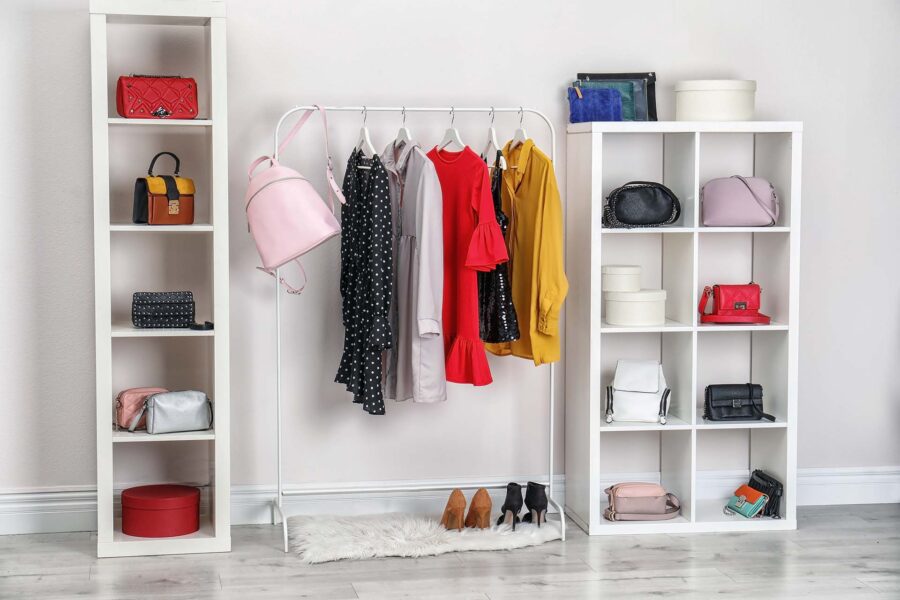
Get the Best Materials for Successful Wrapping
One of the hardest questions to answer when it comes to planning a relocation to another state is: “How to pack clothing?” However, the right packaging materials at your disposal can make a world of difference in ensuring your garments remain in top condition during the transition. Here are all the supplies and materials you’ll need to properly secure your wardrobe collection for relocation.
Wardrobe Boxes
These tall, sturdy boxes come with a metal bar inside, allowing you to transfer your clothing directly from the closet onto hangers within the box. The benefit is that your things remain neatly hung and free from wrinkles during transportation. Wardrobe boxes are a lifesaver for items like suits, dresses, and delicate fabrics that you’d rather not fold.
Packing Paper and Plastic Wraps
Packing paper, often used for fragile items, can be utilized to wrap clothing made of delicate fabrics or materials prone to wrinkling, like silk or lace. Plastic wraps, on the other hand, are excellent for keeping clothes wrinkle-free and protected from dust and moisture. Different materials are particularly useful for items stored in drawers or on shelves that need extra shielding.
Sealable Plastic Bags
You can use them to keep small accessories, like jewelry, belts, or scarves, organized and separate from your clothing. They’re also ideal for grouping sets of outfits or seasonal items together. The transparent nature of plastic bags makes it easy to identify the contents, ensuring you won’t have to rummage through boxes once you arrive at a new place.
Sorting Your Clothes Before Packing
The best way to pack clothes when moving is to begin with sorting. Understanding the importance of this step can make your relocation easier and more organized. So, one of the first strategies is to separate your collection by season. This approach not only makes it easier to wrap but also simplifies the unpacking process.
However, certain clothing items require extra attention during the packing process. Formal wear, delicate fabrics, or expensive garments should be identified and packed with special care. Utilize garment bags, plastic wraps, or paper to protect these items from wrinkles, stains, or damage during the relocation.
Decluttering Is an Inevitable Part of This Job
Sorting also offers an excellent opportunity to declutter your wardrobe, especially if you’re relocating to a smaller house. As you go through your closet, decide what you want to keep, donate, or toss.
Be honest with yourself about the pieces you haven’t worn in ages or those that no longer fit your style. Donating gently used items can be a rewarding part of your relocation, and it reduces the number of items you need to pack and unpack.
For long-distance moves or when transitioning between seasons, consider using a storage unit. This will allow you to store out-of-season pieces and access them as needed.
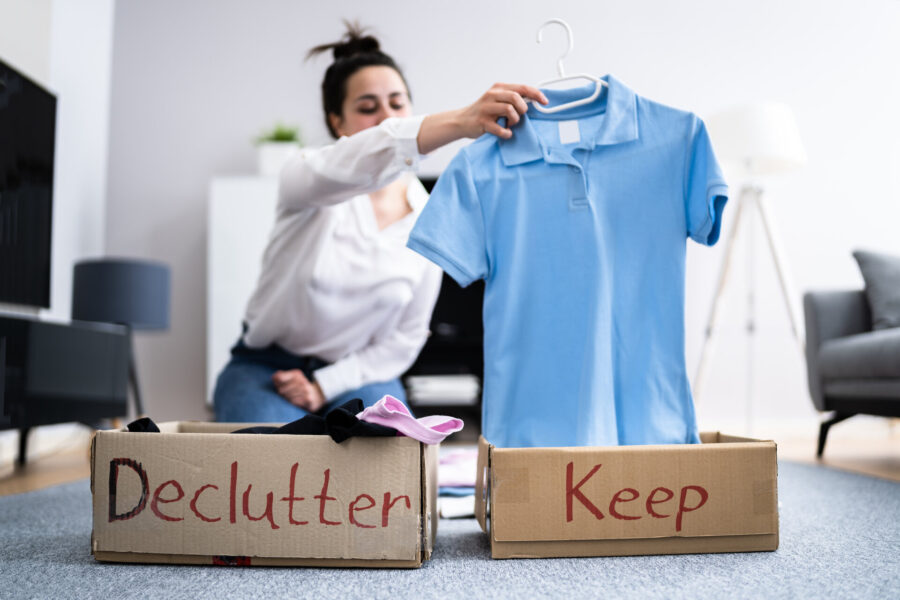
How to Pack Clothes for a Move – All You Need to Know
When it comes to a cross-country move, ensuring your clothing arrives at your new home in the best condition is essential. This guide will walk you through the process, covering everything from folding techniques and wardrobe boxes to footwear and accessories.
Use Proper Folding Techniques and Save Much-Needed Space
One of the most efficient tips that all cross-country movers follow is folding. Effective folding techniques are crucial to maximize space and minimize wrinkles. From t-shirts and jeans to dress shirts and blouses, folding ensures that your things are neatly packed and ready to wear when you unpack. Here are the key things to know when folding your clothes:
- Fold similar items together – Group similar pieces together, such as all your shirts, pants, or dresses, before folding. This keeps your wardrobe organized.
- Master the KonMari fold – Learn the KonMari folding method, a space-saving technique that involves folding clothes into compact rectangles. It helps prevent wrinkles and maximizes space in your boxes.
- Use tissue paper – Place a sheet of tissue paper between clothing items, especially delicate fabrics like silk, to prevent friction and wrinkles.
Transporting Hanging Clothes Has Never Been Easier With Specialized Boxes
Hanging clothes poses a unique challenge during a move, but wardrobe boxes are one of the most efficient solutions for this issue. These specialized boxes with a metal bar inside can transfer your hanging clothes directly from your closet. This method ensures that your suits, dresses, and delicate fabrics remain wrinkle-free throughout your cross-country journey.
Protect Your Shoes Adequately for the Trip
Whether you like wearing sneakers, boots, or Crocs, shoes are an essential part of any outfit. And just like your wardrobe, your shoe collection also needs protection during the move. Here’s what to do to properly prepare your shoes for the trip:
- Clean your shoes – Before packing, make sure your shoes are clean and dry to prevent dirt and odors from spreading to other items.
- Use shoe boxes or bags – Place your shoes in their original shoeboxes, if available. If not, use cloth or plastic shoe bags to protect them.
- Stuff with socks or paper – To maintain the shape of your shoes, stuff them with socks, paper, or bubble wrap. This helps to avoid deformities during the relocation.
- Place shoes in the bottom layer – When packing boxes, place shoes in the bottom layer to provide stability. Fill any gaps with smaller items to maximize space.
- Protect soles – To prevent the soles of your shoes from touching your clothing, place them in a separate bag or use shoe dividers within your boxes.
Take Care of Accessories to Avoid Losing Them
Accessories like belts, hats, and scarves can easily get lost or damaged during a move if not packed correctly. Here’s what to use and ensure everything arrives in one piece:
- Use small bags or pouches – Place small accessories like jewelry, belts, and scarves in individual small bags or pouches. This prevents tangling and damage and keeps them organized.
- Use an accessory organizer – Consider using accessory organizers with compartments or pockets to keep your items separate and protected during the move.
- Label accessories – Label the bags or organizers with the type of accessories they contain, making it easier to find what you need when unpacking.
By following these tips, you can efficiently wrap accessories, fold clothing effectively, and protect your shoes, ensuring that your wardrobe remains organized and in good condition when you arrive at your new home.

Avoid Some Common Mistakes
When preparing to change homes, it’s important to avoid common mistakes to ensure a smoother transition. This is extremely important, especially when you’re doing it yourself instead of hiring a professional long-distance moving company and booking an efficient packing service.
How to Move Clothes – Avoid Overpacking Boxes
One frequent mistake people make when packing is overloading boxes. While it might seem efficient to cram as much as possible into a single box, this can lead to several issues. Overpacked boxes become heavy, increasing the risk of box breakage and can make it difficult to lift and carry.
Additionally, tightly packed clothes are more prone to wrinkling, which defeats the purpose of carefully boxing up your wardrobe. Instead, use appropriately sized boxes and avoid the temptation to overpack them.
Forgetting an Essentials Bag
Another common error is forgetting to prepare an essentials bag for the first few days after the relocation. This bag should contain all the items you’ll need immediately upon arrival at your new home, such as toiletries, a change of clothes, important documents, and any necessities like medication.
Failing to prepare an essentials bag can result in unnecessary stress and digging through boxes to find crucial items. It’s a small but crucial step that can significantly ease the transition and help you settle into your new space with ease.
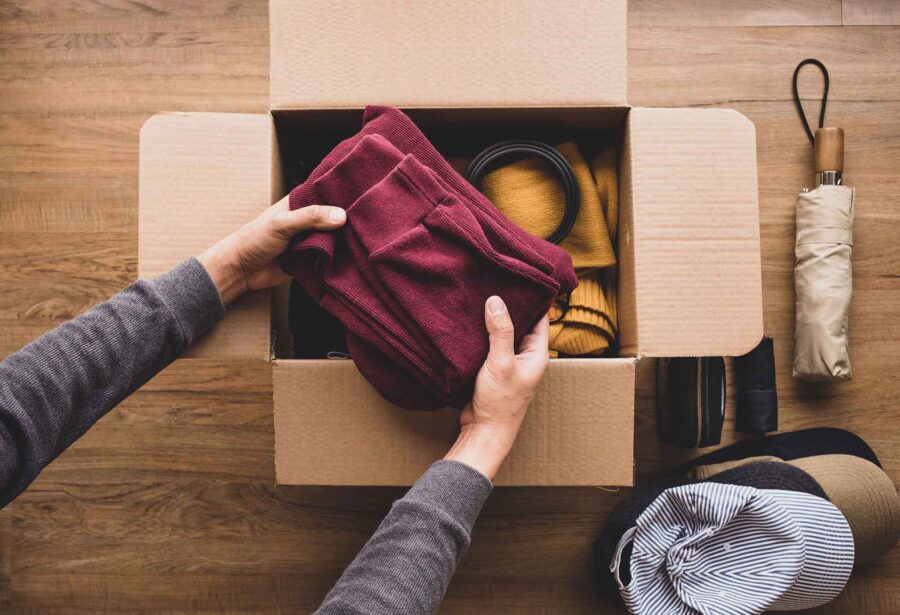
Hire Experienced Long-Distance Movers to Help You With This Tedious Task
Moving long distances can be a daunting undertaking, especially when it comes to protecting and wrapping your clothes at the last minute. This is where experienced long-distance moving services can be a game-changer. Movers not only handle the logistics of transporting your belongings but can also assist with the packing process, ensuring a smooth and stress-free transition.
Entrusting your long-distance move to experienced movers can alleviate the stress and challenges associated with the task, allowing you to focus on other aspects of your relocation.
Packing Services
Our professional packers have methods and techniques to ensure all your items are intact during and after the move.
Corporate Relocation
Are you given the responsibility of the office move? It can be stressful but we can help you plan and get things rolling.
Storage Services
Looking for storage space while you get settled? California-Seattle Express provides 30 days free storage with your move.
Learn How to Pack Clothes When Moving and Have No Worry on Your Mind
Efficient clothing wrapping starts with careful planning and organization. With these tips and a bit of preparation, you can have peace of mind during your relocation, knowing your wardrobe will arrive at your new destination in great condition.
Whether you’re hiring movers from Seattle to California or movers from California to Seattle, the right wrapping techniques can make a world of difference. In case you require any assistance, the team at California-Seattle Express is here to help. Ready to make your move as smooth as possible? Contact us today for professional moving and packing services!
FAQ
Can I Leave Clothes in My Dresser When Moving?
For a long-distance relocation, it’s generally better to empty the drawers. The weight of the clothing can strain the dresser and potentially lead to damage. You can also leave everything as is, but take out the drawers for easier handling.
How Do I Pack Fragile Accessories?
Use small boxes or pouches to prevent tangling and breakage. For added protection, wrap accessories in tissue paper or bubble wrap before placing them in boxes.
What's the Best Way to Pack Clothes for a Move Without Wrinkles?
Use the KonMari folding method or rolling for certain items. Place a sheet of tissue paper between clothing items to reduce friction. Transport hanging clothes in wardrobe boxes to keep them wrinkle-free.
Should I Use Vacuum Bags for Packing Clothes?
These moving bags for clothes are a space-saving option. However, be cautious with delicate fabrics, as vacuum-sealing can compress and damage them over time.
How Many Wardrobe Boxes Do I Need?
The number of wardrobe boxes you need depends on the quantity of hanging clothes. As a general rule, plan for one wardrobe box for every two to three feet of closet space. This estimate can vary based on the types and sizes of your clothing items.
Can I Pack Clothes in Suitcases?
Suitcases can be excellent for protecting clothes. They’re sturdy, easy to transport, and often have wheels for convenience. Utilize suitcases for your everyday clothing and accessories.
How Do I Pack Off-Season Clothes?
Place off-season clothing in clear plastic bins or vacuum-sealed bags. Label each container for easy identification, and store them in a cool, dry place until you need them.
Is It Worth It to Hire Professionals for Packing Clothes?
Hiring professionals for this task can be worthwhile, especially for long-distance moves. They have the expertise and materials to ensure your wardrobe is packed efficiently and securely, saving you time and potential stress.
What Types of Clothes Should Go Into an Essentials Bag?
In your essentials bag, include items you’ll need for the first few days after the relocation. This might include a few changes of clothes, toiletries, important documents, and any necessities like medication.
How Do I Keep My Clothes Organized During the Move?
To keep your wardrobe organized, use clear labels on boxes, organize items by type or season, and consider color-coding or using a spreadsheet inventory. Using color-coded labels or stickers on your boxes can make unpacking much easier.



